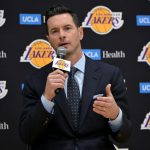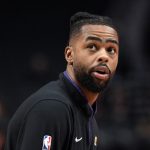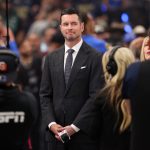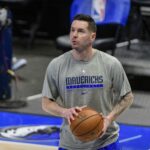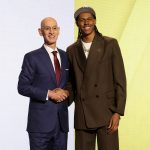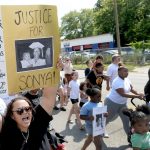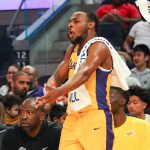The Los Angeles Lakers will be celebrating their 60th season in California this season, but the franchise itself has been around since 1948. Those preceding dozen years were spent in Minneapolis, where they went from being the NBA’s original dynasty to a struggling franchise that eventually picked up stakes to move over 1,900 miles away.
From Pinnacle to Bottom
The central figure in the dynasty portion was George Mikan, whose first six seasons saw the Lakers win five league titles. That made him the NBA’s first superstar, but it was his retirement in 1954 that started the team down a path of departure. Dwindling attendance for much of the next six seasons served as the key.
Mikan did briefly come out of retirement in January 1956, playing 37 regular seasons contests and three playoff games before calling it quits for good. After the Lakers drew only 82,211 for their 31 homes games during the 1956-57 season, the team’s original owners, Ben Berger and Morris Chalfen, sold the team to Minnesota political figure Robert Short in the spring of 1957.
Ownership Change
Short’s first season saw the Lakers crash and burn, as the team finished with a 19-53 record for the 1957-58 campaign. Home attendance actually picked up 31 percent, aided by an offseason ticket push, but by early 1958, talk of moves to Chicago, Kansas City and Washington began surfacing.
The Lakers’ miserable 1957-58 season gave them the top pick in the draft, which they used on Seattle University forward Elgin Baylor. The selection had an element of risk attached, since Baylor originally stated that he would stay in school for one more year. Eventually, Short was able to convince him to sign.
Comeback and Decline
That briefly put the Lakers’ future in Minneapolis on more solid ground, since home attendance more than doubled and their on-court performance also improved. The team finished the 1958-59 season with a 33-39 record in the weak Western Conference. They then managed to upset the St. Louis Hawks for the conference title before being swept by the Boston Celtics in the finals.
Despite finishing 25-50 in what turned out to be its final season in Minneapolis, the 1959-60 edition of the team managed to reach the conference finals again. However, they lost in seven games to the Hawks, with the team’s home attendance dropping an alarming 45 percent.
A frustrated Short was at a loss on how to turn things around.
“They complain about our ticket prices being too high,” said Short. “But now adults can buy a good ticket to our home games for one dollar. That’s as cheap as tickets to other games.”
Moving Signs
Desperation efforts to boost attendance included hiring former Lakers star Jim Pollard as the team’s head coach. Yet Short took note of crowds for the games the Lakers were getting on neutral courts, including in San Francisco and Los Angeles.
The first-ever regular season NBA game in Los Angeles took place on Feb. 1, 1960, when the Lakers took on the Philadelphia Warriors. The Lakers lost, 103-96, but Short obviously took note of the crowd of 10,202 who attended the game at the new Los Angeles Memorial Sports Arena.
Three weeks later, the Lakers and St. Louis Hawks played games on consecutive nights in Los Angeles, with Short offering a strong hint about what those games could mean regarding a potential move:
“A large turnout on successive nights would put Los Angeles No. 1 on the list of a new home for the Lakers if and when we decide to move.”
The Die Is Cast
While the crowds only averaged slightly over 6,000, they impressed Short enough that he offered a bold statement about the Lakers’ future.
“If the league gives permission, it is altogether possible and not unlikely that we will be operating in Los Angeles next season,” Short said.
There were sticking points for Short, who wanted lower rent on the arena. Yet just a few weeks after formally applying to move the team to Los Angeles, he expressed doubts about whether the league would allow him to move.
The San Francisco Lakers?
Had the NBA been so inclined, Short may have ultimately moved his team to San Francisco, since an expansion bid by the proposed Los Angeles Jets was already on the table. In the end, the Jets cast their lot with the fledgling American Basketball League, which delayed their proposed 1960 start before getting underway in October 1961. Just three months into that first season, the Jets folded.
Adding Another Building Block
Prior to a league vote on a Lakers move to Los Angeles, the team had other priorities. This included the 1960 draft, in which they had the second overall selection. They used it to take West Virginia University’s Jerry West, a pivotal move that set the stage for big things down the road.
Move Becomes Official
On April 27, 1960, the NBA granted Short approval to move the team with one caveat: “providing a satisfactory schedule can be drawn.”
Needing only 28 home dates, Short offered the league 70, with most of the home games scheduled to be played at the Sports Arena. The other contests would be split between Los Angeles State (now California State University, Los Angeles), San Francisco and other neutral-site cities.
The agreement that Short worked out with the local Coliseum Commission was that he would pay $2,800 rent for each game. One other component of the NBA’s approval was that Short would pay the travel costs for the league’s other seven teams. To alleviate those costs, the vast majority of games had teams playing consecutive contests in Los Angeles or other West Coast venues.
Short would remain the Lakers’ owner until September 1965, when he sold the team to Jack Kent Cooke. Midway through the 1967-68 season, the team would leave the Sports Arena in favor of the brand new Los Angeles Forum, beginning another era in Lakers history.




